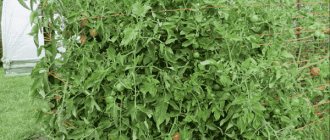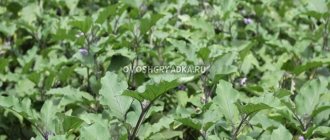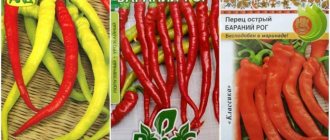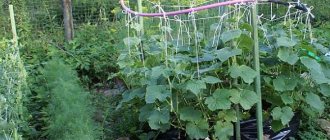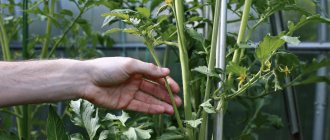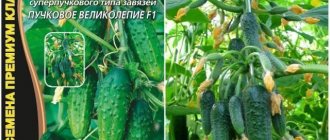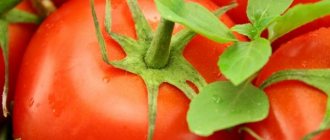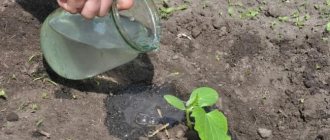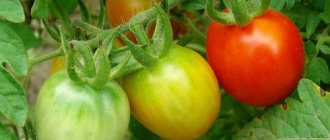Why do you need to shape peppers?
Beginning farmers often underestimate the importance of forming a sweet pepper bush and do not pay enough attention to this procedure, cutting off only dried leaves and shoots.
Did you know? Eating bell pepper stimulates the formation of endorphins in the blood, which are called “hormones of happiness.”
- Proper formation of pepper bushes helps achieve the following goals:
- removal of barren shoots without ovaries, on the cultivation of which the plant wastes energy;
- removing excess inflorescences and ovaries - helps to avoid overloading the plant;
- guarantee of uniform ripening of the crop;
- improving foliage breathability;
- free penetration of sunlight to all fruits and parts of the bush;
- good commercial characteristics of ripened fruits;
- reducing the risk of diseases and pests;
- neat appearance of plants.
What varieties need to be formed
There are many different varieties of peppers, differing in the size of the bushes. And if low-growing varieties do not have too lush green mass, then tall ones can reach a height of 2 m and have dense foliage.
The need for plant formation is determined depending on its height:
- low-growing varieties with a height of up to 50 cm can be grown without formation, provided that they are not planted too close to each other. If the plants are planted densely enough, then you need to trim off excess shoots and leaves to improve air access to the roots and provide lighting to all ripening fruits;
- Medium-sized varieties of pepper grow to a height of about 1 m and require pruning of the lower barren shoots, which needlessly draw juices from the plant. It is also recommended to get rid of some leaves so that the thick green crown does not shade the fruit from the light;
- tall varieties of bell pepper grow up to 2 m and require mandatory shaping. They need to be grown in 1–3 stems, promptly removing stepsons, excess shoots and leaves, as well as stopping the growth of the main branches at the stage of ripening of the formed fruits.
Is it necessary to shape sweet bell peppers?
Forming a bush is an effective technique for increasing the yield and size of bell pepper fruits. With the help of formation, the ground volume of the pepper bush is regulated.
Some gardeners ignore this measure, believing that if favorable conditions are provided, the vegetable will produce a good harvest. However, this is not true for all varieties. Some cannot cope with a large number of fruits on a bush and grow uncontrollably, spending energy on the growth of branches rather than on the fruits, which negatively affects the yield. In addition, the overgrown mass becomes a breeding ground for diseases and pests.
Variety value
The formation of pepper is an obligatory stage of caring for tall varieties and hybrids of this crop, those whose height reaches 1-1.2 m, for example, Kakadu, Hercules, Apollo, Orange Miracle.
It is not necessary to form medium-growing (Anastasia, Greek, Sweet Dragon, Bagel, etc.) and low-growing varieties (Lisichka, Boneta, Timoshka, Fakir, etc.).
When to form a bush
Typically, peppers are grown from seedlings and then transplanted into a greenhouse. But the formation of the plant must begin even before it is transplanted into the greenhouse. Typically, a seedling begins to branch after it reaches a height of 15–20 cm.
Important! When planting pepper seedlings in a greenhouse of 1 sq. m area can be no more than 5
–
6 plants.
At the same time, there should be free space around the seedlings to increase their volume by 2 -
3 branches.
At this stage, the first formation of the sprout is carried out. Further formation is carried out according to the rules described later in the article.
Basic rules for forming a bush
The formation of a pepper bush is carried out gradually. It consists of several important steps and takes time. Let's take a closer look at the basic rules for plant formation.
- Removing the crown bud. It is carried out at the stage of seedling growth, when the stem of the seedling branches into 2 separate powerful shoots. In this case, a bud is formed between these branches, which is called a crown bud. In order for the seedling to continue to actively grow and branch, the crown bud should not bloom, so it is removed. If you plan to use seeds obtained independently to grow sweet peppers next year, then the crown bud is left on 1–2 plants, since it produces the highest quality seeds for planting.
- Trimming excess shoots. In the process of further growth, the main stem begins to branch. In the fork on which the crown bud was removed, several new shoots are formed. Of these, 2–3 of the most powerful ones are selected, and the tops of the remaining shoots are cut off.
- Trimming lower leaves and barren shoots. Under the first fork on the main stem, side shoots and leaves begin to grow. Such shoots are called sterile and are pruned. Too many leaves shade the fruit and can slow down their ripening, so they are also removed. It is equally important to trim damaged, dried and disease-affected leaves, since from them the infection can spread to the entire bush.
- Pinching the tops of the stems of the first order. It is carried out after about 15–20 fruits have formed on the branches. In this case, further growth of the main shoots will not increase the total amount of harvest, but will only take away the plant’s strength, so the tops of such shoots are pinched so that the resulting fruits grow large, sweet and can ripen on time.
Did you know? Bell pepper is actively used in cosmetology for the production of anti-aging face masks and hair care products.
Formation of pepper in open ground
- When growing peppers in open ground, only tall varieties and hybrids can be formed.
- In medium-sized plants, sterile fattening shoots, lower shoots and stepsons must be removed to provide the bush with normal lighting and ventilation.
- Low-growing varieties of pepper do not need shaping.
Crooked, broken shoots that grow inwards must be removed. On medium- and low-growing pepper bushes, pinching of the central shoots is carried out to enhance lateral branching.
Formation of bushes in open ground in the following sequence:
- When the peppers get stronger and reach 27-30 cm, their primary buds are removed. The buds on the side shoots are also cut off. This will provoke the growth of additional branches. The seedlings will begin to bush.
- All subsequent shoots are formed in the same way: 3–5 shoots are left. The stems above the first flower and leaf are removed.
- Always cut off the leaves and growth on the main trunk before the first fork.
- After a sufficient number of fruits appear, all skeletal branches are pruned at the growth point.
- The last procedures for pruning bushes are performed 5-6 weeks before the end of fruiting.
The total number of fruitful shoots of pepper does not exceed 4-6, and the number of fruits, depending on the variety, is 15-25.
On a note! After removing the growing point on all shoots, the plant will give all its energy only to ripening the fruits, filling them with juice and vitamins.
Formation methods with step-by-step instructions
Under ideal conditions in a polycarbonate greenhouse, pepper bushes begin to grow actively. In order not to overload them with a large green mass and at the same time not to cause them stress by excessive pruning, you need to form the bush correctly. Most often, peppers in a greenhouse are grown with 1, 2 or 3 stems. The method of formation depends on how many plants are placed in the greenhouse.
In one stem
This method of formation is used when the plants are planted very close to each other and there is not enough space in the greenhouse to grow voluminous bushes.
Step-by-step instructions for forming a pepper into one stem are presented below:
- The formation of a bush begins at the stage when the main stem of the plant branches into several side shoots.
- Remove any side shoots that begin to form as offshoots from the main stem. You should end up with a straight bush with one straight stem on which leaves and flower clusters grow.
- If during the process of plant growth, forks form again on the main stem, then they are carefully cut off, leaving only the flower bud and 1-2 leaves above it.
- When 10–12 fruits form on the bush, you need to pinch out the top growing point on the stem. This will ensure the ripening of the formed fruits, and also stop the growth of the plant in height.
In two stems
This method of forming peppers is the most common and allows you to get a neat V-shaped plant that holds at least 20 large fruits.
Let's look at the step-by-step instructions for forming a pepper into two stems:
- This formation must begin at the stage when the main stem of the plant branches into several side shoots.
- Trim off all side shoots extending from the main stem, except for the very first shoot. You should get a bush with two stems of the first order.
- When branches of several shoots begin to form on the shoots of the first order, leave one of the strongest ones and cut off the rest above the level of the first flower bud and one leaf.
- Repeat the steps from the previous paragraph for shoots of the second, third order, and so on until about 20 ovaries are formed on the bush.
- Pinching the tops of the two main shoots of the first order. This will help stop the growth of the plant in height and ensure the ripening of the resulting fruits.
Three stems
Pepper bushes, which are grown in three stems, take up quite a lot of space in the greenhouse, but produce a larger yield of fruits with good commercial characteristics.
Important! This method of forming a bush helps to achieve the best lighting for all peppers, as a result of which the crop ripens faster.
A step-by-step algorithm for forming a pepper bush into three stems is described below:
- The formation of a bush begins at the moment when the main stem of the plant branches into several side shoots.
- If the main stem immediately splits into 3-4 strong shoots, then only 3 branches are left, and the extra shoots are pinched out.
- If at a fork the stem branches only into 2 parts, then the formed branches of the first order are not cut off and wait until the next strong shoot appears, extending from the main stem.
- After the 3 main strong branches of the first order are selected, forks also begin to form on them. At each fork, only the strongest shoot is left, and the rest are pinched. When pruning excess branches, only the first flower bud and a couple of leaves above it are left.
- Repeat the steps from the previous paragraph for shoots of the third order and so on until about 25 fruits are formed on the bush.
- Pinching the tops of the three main branches of the first order. This helps stop the plant from growing in height and ensures the ripening of the resulting fruits.
Scheme of pepper formation into one, two and three stems:
What techniques are used
When forming a bell pepper bush according to any scheme, the same techniques are used. This is pinching, pinching, pruning. It is important to know where and on which branches each technique is needed.
Stepsoning
A stepson is a shoot formed in the axil of a leaf or at the base of a formed shoot. Stepchildren must be removed completely, leaving a “stump” of no more than three millimeters. As a rule, these are weak branches that will not produce normal fruits. If you leave them, the plant will spend extra energy, which it could direct to full-fledged peppers. There is no need to plant dwarf and ornamental varieties.
Topping
Pinching allows you to stop further development of the shoot by removing the growing point. This eliminates unnecessary side branches. Pinching is carried out taking into account that the ovary and one or two leaves should remain on the shoot. You cannot leave only the flower bud and remove all the leaves. In this case, the plant will not have enough strength to set fruit.
You need to pinch out shoots of the second and third order, forming a neat, well-fruiting bush. In the same way, the growth points of all shoots are removed when the required number of fruits on the plant is reached.
Trimming
Pruning involves removing parts of the plant using special tools (garden shears, knife, pruning shears...). What to trim from peppers:
- shoots and leaves below the first fork;
- barren, “fat” branches;
- diseased, twisted shoots inside the crown;
- too densely growing leaves that interfere with the penetration of light.
You should also trim the first, royal bud. It forms in the middle of the first fork; if left, it will produce the largest pepper, but will take a lot of effort to form the remaining fruits. It is advisable to leave the royal bud to obtain seeds - in it they ripen healthy and full-fledged.
Basic Techniques
To properly form a pepper bush, three main techniques are used: pinching, pruning leaves and pinching stems. Each of these procedures must be carried out according to certain rules, which will be described later in the article.
For clarity, consider a diagram of the structure of a pepper bush grown in a greenhouse (see figure):
1 - main stem of the bush; 2 - shoots of the first order; 3 - second order branches; 4 - skeletal shoots.
Black horizontal strokes indicate places where shoots are pinched. Let's take a closer look at the basic techniques for plant formation.
Stepsoning
This technique involves removing stepsons - small lateral processes that form in the axils of the leaves during the growth and branching of the stem and shoots. They take away the strength from the plant that is needed to produce a large number of large and beautiful fruits.
Find out more about whether bell peppers need to be pinched.
Basic recommendations for planting bell pepper bushes are presented below:
- removal of stepchildren should be carried out only after the plant reaches a height of 30 cm and its main branches are sufficiently strong;
- all small side shoots that appeared under the branching point on the main stem must be removed;
- when removing stepsons, it is recommended to leave stumps about 3 mm high so that the plant is not exposed to diseases or attack by pests;
- pinching of plants is carried out early in the morning, and after the procedure the ground around the bush is loosened and watered;
- Stepchildren can only be removed with sharp and disinfected instruments.
Topping
The key to a bountiful harvest is not only a large number of fruit ovaries, but also their timely and complete ripening. With uncontrolled growth of shoots, numerous ovaries can form, but they will only draw juices from the bush and will not be able to produce a full harvest. To avoid this, carry out the procedure of pinching the shoots.
The basic rules for pinching peppers are described below:
- when the main stem of the plant branches into several parts, they are pinched, leaving only 2–3 of the most developed stems, which form the skeleton of the bush;
- when another branch of several shoots forms on the skeletal branches of the plant, only the most developed of them is left, and the rest are pinched;
- when further branches of several shoots form on second-order shoots, you need to leave only the strongest of them, and cut off the rest above the flower bud;
- after a sufficient number of fruit ovaries have formed on the bush, the growth points on all main shoots are pinched;
- The last pinching of the stems should be done no later than 1 month before the end of fruiting of the bush.
Typically, it is recommended to leave about 20–25 fruit ovaries on one pepper bush.
Trimming
In order for the ovaries formed on the bush to turn into large fruits and ripen on time, they need to be provided with good access to light and air. For this purpose, unnecessary leaves are trimmed, which shade the plants too much and take away excess nutrients from them.
Did you know? On the territory of Russia, bell pepper appeared in the XYI–XYII centuries. At that time it was grown only as an ornamental plant.
This procedure must be performed according to the following rules:
- all dried and damaged leaves must be removed;
- pruning of green leaves should be carried out only on healthy bushes, since after this procedure the plants are more susceptible to disease and attack by possible pests;
- leaves on the main stem can be removed after the peppers on the first order shoots have reached the stage of technical ripeness;
- no more than 2 sheets can be removed per trimming;
- when the peppers of the second cluster have reached technical ripeness, you can pick off the leaves located under it, and so on;
- when trimming excess leaves, you need to ensure that 1–2 leaves remain on the stem above each ovary or fruit, since they provide nutrition to the fruit;
- The last pruning of the leaves is done 1.5 months before all the fruits are fully ripened.
Video: How to shape peppers in a greenhouse
How to do it correctly and which peppers do not require shaping
Speaking about the rules for forming peppers, experts and experienced gardeners remind that the main rule of picking is to remove all the stepsons and leaves that are located below the main branches. Even if flowers form on them, these parts of the plant are not needed for further fruiting.
Then, two or three main shoots are left. Next, when a fork forms on the main shoot, pinch off the growing point, saving the rest for further growth. On the remaining shoots, it is also important to ensure that the main leaves and fruit remain, and it is also better to pinch the growing point. You need to do the same with the rest of the main and side shoots.
Sometimes the plant itself forms 3 shoots. In this case, pinching is not required. It itself forms a sufficient number of ovaries and fruits. If pollination is weak, it is advisable to do it yourself, using a regular small brush. We collect pollen with a brush and apply it to the stigma of the flower. This way you can be sure that all the flowers will yield a harvest as a result.
Forming is necessary for tall and large types of pepper. Low-growing varieties, as well as those varieties that have a weak branching ability, do not need to be formed. Most hybrid varieties also do not need to be formed, since they do not grow excessively.
Low-branching varieties that do not require formation include:
- Florida,
- Zodiac,
- Barguzin,
- Alesha Popovich,
- Bagration,
- Victoria,
- Bogatyr.
Hybrid varieties with weak branching:
- Pinocchio F1,
- Othello F1,
- Claudio F1,
- Maxim F1,
- Goodwin F.
They also do not require special formation.
Aftercare
In order for the farmer to have a good harvest of sweet peppers at the end of the season, in addition to proper formation, the bushes need to be provided with the necessary care.
The basic rules for caring for peppers in a greenhouse are listed below:
- watering as needed, but at least once every 5–7 days. Water for irrigation should be warm, about 2 liters are consumed per plant;
- ventilation of the greenhouse to reduce humidity levels and prevent condensation;
- feeding plants with mineral fertilizer complexes after transplanting seedlings, before flowering and at the stage of fruit formation;
- loosening the top layer of soil around the bushes to improve air permeability;
- protecting plants from direct sunlight in hot weather (above +30°C);
- tying side shoots to installed supports to balance the plants.
Important! In hot weather, pepper bushes need to be watered at least 2 times a week.
Caring for plants after formation
The process of pinching and forming bushes is stressful for plants. After the procedure, the pepper needs proper and competent care so that the plant quickly recovers and continues to grow.
Initially, the bushes are tied to trellises and supported so that the branches do not break under the weight of the ovary. Carry out regular irrigation with warm water. Water early in the morning or late in the evening. The next watering is combined with the application of fertilizers.
Useful tips
If you adhere to all the rules for forming a bush described above, you can get a bountiful harvest of pepper with high commercial qualities.
But to ensure that pruning and pinching shoots do not harm the plant, you need to follow a few more recommendations:
- Only healthy plants can be formed; diseased bushes may die as a result of this procedure.
- Pruning of all shoots and leaves is carried out with sharp instruments, disinfected in a solution of any antiseptic.
- It is impossible to form pepper bushes in a greenhouse during extreme heat - the lush green mass helps protect the stem from burning out.
- The pruning and pinching procedure is best done early in the morning, when there is no scorching sun rays.
- Plants that have not reached a height of 20 cm should not be grown, as pruning can lead to the death of the young plant.
- If the pepper bushes in the greenhouse are planted very far from each other and the leaves do not touch, then the green mass is not pruned.
The procedure for forming pepper bushes requires time, patience and some effort from the farmer. But if you carry out pruning and pinching taking into account all the recommendations described, then at the end of the season the plants will definitely delight you with an excellent harvest of tasty and beautiful peppers.
Common Mistakes
A common mistake is pinching bushes located at a distance of more than 20 cm from each other. With such sparsely planted bushes, the green mass is left behind.
Reference. Many gardeners are in a hurry to remove new leaves and shoots. This is also a mistake. No more than two leaves are removed per day. Otherwise, the plant will experience severe stress and may die.
Insufficient attention of the vegetable grower to disinfection of the tools used for pinching and pruning can cause the plant to become infected. Disinfect instruments with alcohol and chlorine-containing preparations.
Another common mistake is pinching and pinching in wet and rainy weather, which again increases the risk of infection. The procedures are carried out in dry weather so that the sections dry faster.
Many gardeners leave a large number of ovaries on the plant , mistakenly believing that they form fruits. In fact, in this case the plant spends energy on developing unnecessary areas.
